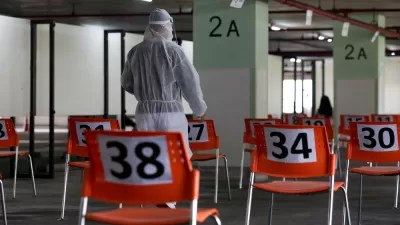How do you navigate a city with no street names? This is the question Amanda Erickson sets out to answer in an article on photographer Regina Mamou, who spent a year studying how the people of Amman get around.
Hand-drawn maps, navigation by landmarks, calling from rooftops -- these are just some of the navigational devices utilized by residents of Amman, Jordan, a city that until only two years ago had unlabeled streets and unnumbered buildings.
"'It's totally normal to be lost and confused,' says photographer Regina Mamou...Little has changed even though many houses now have numbers. Mail is
still delivered to P.O. boxes; even Fed Ex officials call and ask for an 'interpretation' as to where a spot is located."
"This form of urban living has meant that people form very personal
relationships with their neighborhoods. But it also means Jordanians may
be less likely to explore a city as a whole. 'Living in the Middle
East, there's a lot of different ways in which the subjectivity of the
landscape is present. As a woman, there are places you will go or won't
go,' Mamou says. 'It also depends on where you are in the economic scale
as well.'"
FULL STORY: How Do You Navigate a City With No Street Names?

Trump Administration Could Effectively End Housing Voucher Program
Federal officials are eyeing major cuts to the Section 8 program that helps millions of low-income households pay rent.

Planetizen Federal Action Tracker
A weekly monitor of how Trump’s orders and actions are impacting planners and planning in America.

Ken Jennings Launches Transit Web Series
The Jeopardy champ wants you to ride public transit.

Milwaukee Road to Get Complete Streets Upgrades
The city will reduce vehicle lanes and build a protected multi-use trail including bioswales and other water retention features on its ‘secret highway.’

Tackling Soil Contamination With Nature-Based Solutions
Los Angeles County residents and experts are turning to nature-based methods like bioremediation to address long-standing and fire-exacerbated soil contamination without resorting to costly and disruptive removal.

Rebuilding Smarter: How LA County Is Guiding Fire-Ravaged Communities Toward Resilience
Los Angeles County is leading a coordinated effort to help fire-impacted communities rebuild with resilience by providing recovery resources, promoting fire-wise design, and aligning reconstruction with broader sustainability and climate goals.
Urban Design for Planners 1: Software Tools
This six-course series explores essential urban design concepts using open source software and equips planners with the tools they need to participate fully in the urban design process.
Planning for Universal Design
Learn the tools for implementing Universal Design in planning regulations.
Ada County Highway District
Clanton & Associates, Inc.
Jessamine County Fiscal Court
Institute for Housing and Urban Development Studies (IHS)
City of Grandview
Harvard GSD Executive Education
Toledo-Lucas County Plan Commissions
Salt Lake City
NYU Wagner Graduate School of Public Service



























